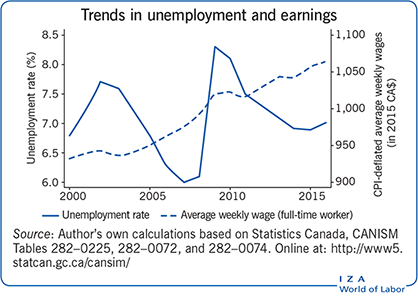Elevator pitch
During the 2000–2016 period, Canada’s economy and labor market performed well. An important element in this success was the strong resource boom that lasted from the late 1990s to 2014. Since that time the economy and labor market have been undergoing a painful adjustment, a process that is now essentially complete. A good rule of thumb when examining many aspects of the labor market, such as the extent of unionization and the level of the minimum wage relative to the median wage, is that Canada is situated roughly halfway between the US and Europe.

Key findings
Pros
Economic downturns during 2000–2016 were much less pronounced than during the 1980s and 1990s.
Recent recessions in Canada have been much milder than in the US and much of Europe.
Real wage gains from 2000 to 2016 were substantial—and much greater than during the preceding 20 years.
After rising markedly during the 1980s and 1990s, income inequality has been relatively stable since 2000.
The male–female earnings gap has continued to decline.
Cons
Since the end of the resource boom in 2014, the labor market has been undergoing substantial labor reallocation due to job losses and unemployment in resource rich regions.
Real earnings gains have been very unevenly shared, with especially large increases at the top of the income distribution.
The labor market became increasingly polarized in terms of “good” (high-skill and high-paid) and “bad” jobs between 1970 and 2000, though it has since stabilized.
With the resource boom over, one concern is that income inequality and job polarization will resume growing over time.